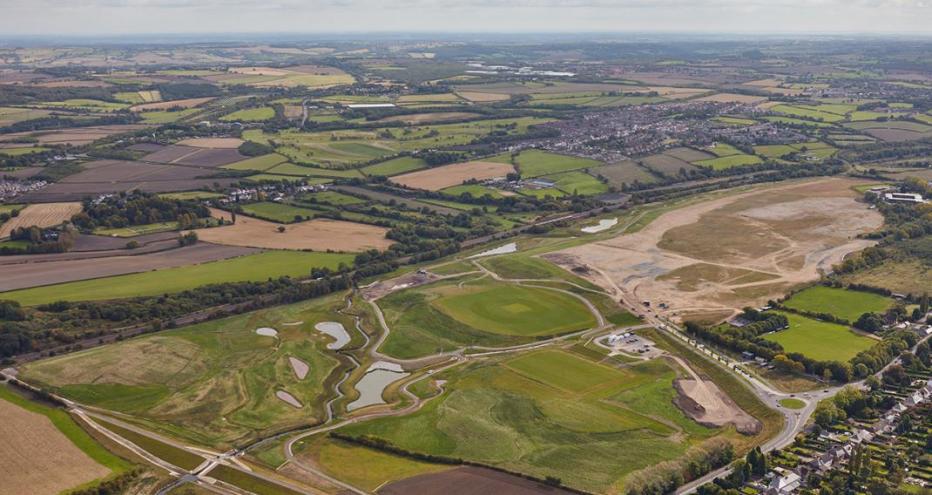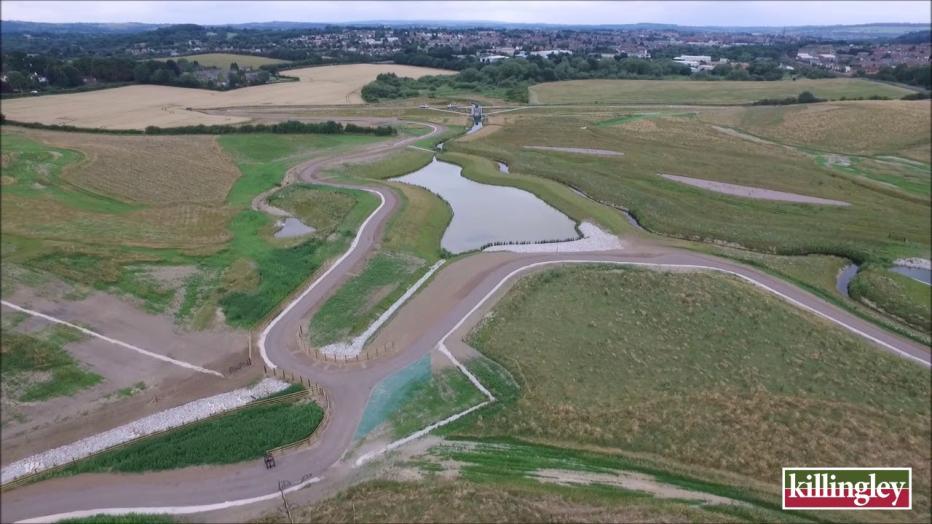Soil needs care and nurture to remain a productive, growing habitat, so tackling soil pollution is critical to minimizing the risks for the environment, food security and human health. Celebrate the transformational change at the award-winning Avenue Remediation and Landscaping Project – one of the most significant and complex remediation projects ever to take place in the U.K.

Almost 20 years in the making, Jacobs, with client Homes England, VSD Avenue and Turner and Townsend, delivered the restoration of heavily polluted industrial land at the former Avenue Coking Works in the East Midlands, U.K. One of the most significant and complex remediation projects ever to take place in the U.K., the award-winning remediation program has transformed 98 hectares into a place that can now be enjoyed by the community and wildlife.
Closed in 1992, the site left a legacy of derelict plant and heavy pollution, including open tar lagoons, waste tips containing asbestos and contamination of the underlying soils, groundwater and adjacent river. Conventional solutions to the huge pollution issues were unsuitable, so the project team used a combination of techniques such as ex-situ bioremediation, screening and thermal desorption. The environmental management plan included monitoring and management of air-quality, water, ecological and biodiversity impacts.
The restored landscape provided a development platform with space for almost 500 new homes, and 70 hectares of open public space incorporating a sustainable drainage system, high quality community sports facilities, multi-user trails, woodland, and new habitats for wildlife.
-
1
of more than 100 legacy coalfield assets managed by Homes England
-
98 ha
of transformed space to be used and enjoyed by the community and wildlife
-
8000
newts, 250 water voles and other species provided with suitable alternative areas to relocate
-
20
(almost) years in the making
Recognized with the Judges' Special Award at the 2018 Brownfield Briefing Awards, a 2018 Project Merit: Brownfield Redevelopment award from the Environmental Business Journaland the CEEQUAL Excellent Whole Project Final Award, this 19-year remediation program has transformed 98 hectares into a place that can now be used and enjoyed by the community and wildlife.
With a total project value of $230 million (£180 million), this project is an example of what can be achieved with even the most difficult of sites. The remediation strategy was developed to address the clean-up and restoration of the land, which was previously a coking works, and was integrated with short term environmental management requirements as well as the masterplan to deliver the community’s long-term aspirations for the site. For World Soil Day, we dig deeper – pun intended – into soil pollution to understand just what it took to restore the landscape – bringing long-lasting environmental, social and economic benefits and resiliency, habitats for wildlife and a development platform for community and residential opportunities.
The Avenue Remediation

Legacy of heavy pollution
One of over a 100 coalfield assets managed by Homes England (under its National Coalfields Programme portfolio) on behalf of the U.K. Government, the site of the former Avenue Coking Works was once known as one of the most contaminated industrial sites in Western Europe. The plant opened in 1956 in Chesterfield and produced smokeless solid fuel through the carbonization of coal. When the site closed in 1992, it left a legacy of derelict plant and heavy pollution, including open tar lagoons, waste tips containing asbestos and contamination of the underlying soils, groundwater and adjacent river. Much of the soil on the site was contaminated with hydrocarbons with elevated levels of cyanide and arsenic also present.
Remediation works commenced in earnest in 2009, however the concept which underpins the project had taken more than a decade to develop. Between 1999 and 2005, an extensive program of environmental management and investigation took place which included plant area draindown, site surveys and ground investigation, through to remediation trials and development of the remediation strategy.
The success of the project has been driven by the belief of the whole team, including regulators and local authorities, that it was possible to deliver a truly remarkable transformation of the site.
Working with client Homes England, contractor VSD Avenue, and NEC Project Manager Turner and Townsend, Jacobs supported the entire 19-year remediation program delivering a wide variety of technical services. Initially these included conceptual design, ground investigation, risk assessment and the development of the overall strategy for the site. Later, our team supervised the remediation and landscaping contract, providing technical advice to the client team and verifying that the work to clean the site met the overall remedial objectives.
“This program has taken nearly two decades of meticulous planning and execution with Homes England and their partners to restore one of Europe's most complex remediation sites into an area that can be enjoyed by the community for years to come. The scale of the change at the site continues to amaze people when they visit and we take significant pride in sharing the history of the project and the technical innovations which have brought it to this stage.”
Remediation on a grand scale
Given the nature of the site and the scale of contamination it contained, remediation posed significant technical challenges which required a combination of techniques to overcome. Conventional solutions to the huge pollution issues that existed, such as off-site landfill disposal or in-situ encapsulation, were considered unsuitable. The project team needed to find a better way and an ambitious strategy was developed that would serve to make the site exemplary within the National Coalfields Program.
Each cubic metre of excavated material would be placed at locations within the site based on compliance with the various project specific chemical and geotechnical criteria. These criteria were provided to ensure that the River Rother was protected from pollution, that people could use and live on the site safely and that the landform could structurally support its intended uses.
The sediments which filled the lagoons on either side of the River Rother had long posed a threat to the river itself and were one of the fundamental drivers of the project. Extensive trials showed that the only system which would reliably treat these materials was likely to be thermal desorption. At the time, this method of remediation was largely unproven in the U.K., but significant research confirmed the resilience of the system. Developed by VSD Avenue, a bespoke thermal desorption unit was erected on site and operated on a 24/7 basis between 2010 and 2013. It was the first time the technique was used on such a large scale in the U.K.
The project team was determined to not just manage materials as waste, but to create materials which added value. Remarkably, the output from the thermal process was safely reused in almost exactly the location from which it had originally been obtained. The alternative being conventional and much less sustainable solutions which might have seen it transported from site as a hazardous waste.
Less contaminated material, like leachable contaminants associated with the former plant area, were treated using ex-situ bioremediation. In choosing this method of remediation, the team essentially facilitated a natural and sustainable cleaning process in many of these types of materials.
At all times, a key priority was to strike a balance between intervention and management. Screening and soil sorting were deployed where they would add most value rather than treating soils with more intensive techniques. The landform was specifically designed to incorporate all the treated materials, with minimum requirements to import new or reclaimed soils.
With the remediation works complete, the restored landscape now provides a development platform with space for almost 500 new homes, along with an additional 70 hectares of open public space incorporating a sustainable drainage system, high quality community sports facilities, multi-user trails connecting to local cycle networks, woodland, car parking, new habitats for wildlife as well as a reed bed and flood alleviation dam.
Kier Living has recently commenced work on the future housing development with the first new homes likely to be occupied in early 2019. Further developments will take place in the coming years including the expected provision of a primary school and associated community facility. Wildlife is re-establishing itself in the newly landscaped areas and the newly opened public space is proving to be very popular with the local community.
The benefits of the project stretch beyond the transformation of the site and serve to enhance the environment for the wider community of Chesterfield and North Derbyshire. All around the site, there is significant population growth in new developments. These would not have been viable in such close proximity to a site of this type in its original condition.
The communities who use the site may never fully realize the extent of the journey that allowed the site to take on its current form. From remediation trials in Rotterdam to detailed scientific assessments in Manchester, the completed landform is a logistical and technical feat.
Winning the Judges' Special Award at the 2018 Brownfield Briefing Awards, the project was recognized for the remarkable transformation achieved on the site, and the sheer scale and complexity of the challenges that have been overcome.There has only been one previous special award in the 14-year history of the awards and the judges commended the “long-term, large scale, technically and logistically complex project” and it providing "valuable practical experience for many in the industry.”














































